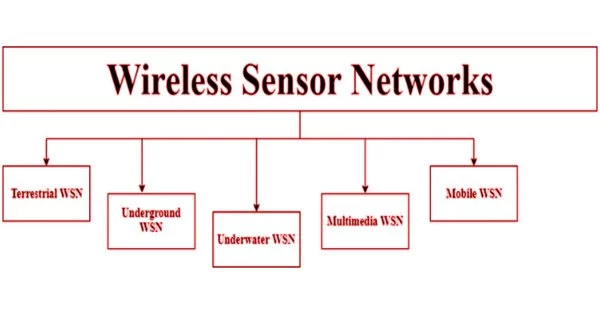WSNs are self-configured and infrastructure-free wireless networks that monitor physical or environmental conditions such as temperature, pressure, motion, sound, vibration, or pollutants and directly transmit their data or information through the network to a sink, also known as the main location where the information is frequently observed and analyzed.
Classifications of Wireless Sensor Networks are as follows:
1. Static and Mobile WSN:
These networks are static WSNs because all of the sensor nodes in various applications can be set without movement. In many applications, all sensor nodes are connected without moving, resulting in static networks. Mobile sensor nodes, also known as mobile networks, are used in many applications, including biological systems. Mobile sensor nodes are required in some applications, particularly in biological systems. Animal monitoring is the best example of a mobile network. This is referred to as a mobile network. Animal monitoring is a type of mobile network.
2. Deterministic and Nondeterministic WSN:
The sensor node position is calculated and fixed in deterministic wireless sensor networks. The sensor node arrangement in a deterministic network can be fixed and calculated. Pre-planned operation of this sensor node is only possible in a few applications.
Sensor node deployment is possible in a limited number of applications. Because of factors such as harsh environments or hostile operating conditions, determining the position of sensor nodes is not possible. Such networks are non-deterministic and necessitate a complex system.
3. Single Base Station and Multi Base Station WSN:
In single base station WSNs, only one base station is used, which is located near the sensor node region. The base station can facilitate communication between sensor nodes. All nodes communicate with this base station; in the case of multi-base station WSNs, more than one base station is used, and a sensor node can transfer data to the closest base station. Multiple base stations are used in a multi-base station network, and a sensor node is used to move data toward a nearby base station.
4. Static Base Station and Mobile Base Station WSN:
Base stations, like sensor nodes, are either mobile or static. As with sensor nodes, WSN base stations are frequently either static or mobile. A static base station has a fixed location, which is usually near the sensing region.
The static type base station, as the name implies, maintains a stable position close to the sensing area, whereas the mobile type base station moves in the sensor region to balance the load on the sensor nodes. Because the load on sensor nodes is balanced, a mobile base station WSN moves around the sensing region.
5. Single-hop and Multi-hop WSN:
The sensor nodes in single-hop WSNs are directly connected to the base station. The arrangement of sensor nodes in a single-hop network can be done directly toward the base station, whereas in a multi-hop network, both the cluster heads and peer nodes are used to transmit data to reduce energy consumption. In the case of multi-hop WSNs, peer nodes and cluster heads are used to relay information in order to reduce energy consumption.
6. Self Reconfigurable and Non- Self Configurable WSN:
Sensor networks cannot organize themselves in a network and consider a control unit to gather data in non-Self Configurable WSNs. Many WSNs allow sensor nodes to organize and maintain connections, as well as collaborate with other sensor nodes to complete tasks.
7. Homogeneous and Heterogeneous WSN:
In the case of homogeneous WSNs, all sensor nodes consume the same amount of energy, have the same storage capabilities, and have the same computational power. In the case of heterogeneous WSNs, some sensor nodes require more computational power and energy than others, and the processing and communication tasks are distributed accordingly. In the case of a heterogeneous network, some sensor nodes require more computational power and energy than others. As a result, the processing and communication tasks are separated.
















